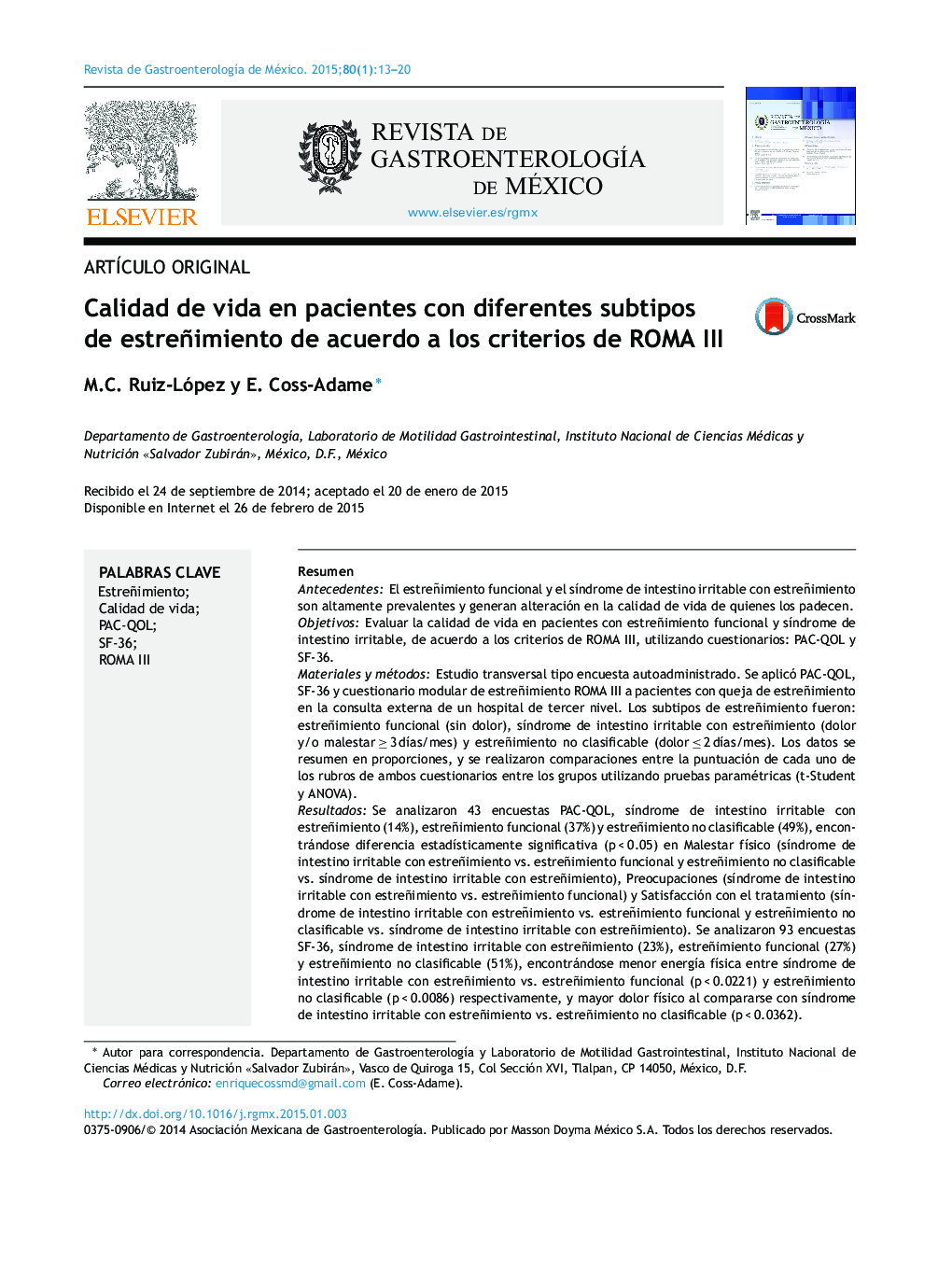| Article ID | Journal | Published Year | Pages | File Type |
|---|---|---|---|---|
| 3318737 | Revista de Gastroenterología de México | 2015 | 8 Pages |
ResumenAntecedentesEl estreñimiento funcional y el síndrome de intestino irritable con estreñimiento son altamente prevalentes y generan alteración en la calidad de vida de quienes los padecen.ObjetivosEvaluar la calidad de vida en pacientes con estreñimiento funcional y síndrome de intestino irritable, de acuerdo a los criterios de ROMA III, utilizando cuestionarios: PAC-QOL y SF-36.Materiales y métodosEstudio transversal tipo encuesta autoadministrado. Se aplicó PAC-QOL, SF-36 y cuestionario modular de estreñimiento ROMA III a pacientes con queja de estreñimiento en la consulta externa de un hospital de tercer nivel. Los subtipos de estreñimiento fueron: estreñimiento funcional (sin dolor), síndrome de intestino irritable con estreñimiento (dolor y/o malestar ≥ 3 días/mes) y estreñimiento no clasificable (dolor ≤ 2 días/mes). Los datos se resumen en proporciones, y se realizaron comparaciones entre la puntuación de cada uno de los rubros de ambos cuestionarios entre los grupos utilizando pruebas paramétricas (t-Student y ANOVA).ResultadosSe analizaron 43 encuestas PAC-QOL, síndrome de intestino irritable con estreñimiento (14%), estreñimiento funcional (37%) y estreñimiento no clasificable (49%), encontrándose diferencia estadísticamente significativa (p < 0.05) en Malestar físico (síndrome de intestino irritable con estreñimiento vs. estreñimiento funcional y estreñimiento no clasificable vs. síndrome de intestino irritable con estreñimiento), Preocupaciones (síndrome de intestino irritable con estreñimiento vs. estreñimiento funcional) y Satisfacción con el tratamiento (síndrome de intestino irritable con estreñimiento vs. estreñimiento funcional y estreñimiento no clasificable vs. síndrome de intestino irritable con estreñimiento). Se analizaron 93 encuestas SF-36, síndrome de intestino irritable con estreñimiento (23%), estreñimiento funcional (27%) y estreñimiento no clasificable (51%), encontrándose menor energía física entre síndrome de intestino irritable con estreñimiento vs. estreñimiento funcional (p < 0.0221) y estreñimiento no clasificable (p < 0.0086) respectivamente, y mayor dolor físico al compararse con síndrome de intestino irritable con estreñimiento vs. estreñimiento no clasificable (p < 0.0362).ConclusionesUtilizando los cuestionarios PAC-QOL y SF-36 se identifican diferencias en la calidad de vida en los subtipos de estreñimiento. Los pacientes con la variante síndrome de intestino irritable con estreñimiento experimentan menor calidad de vida en todos los dominios evaluados.
BackgroundFunctional constipation and irritable bowel syndrome with constipation are highly prevalent and affect the quality of life of those who suffer from them.AimsTo evaluate quality of life in patients with functional constipation and irritable bowel disease in accordance with the Rome III criteria, using the PAC-QOL and SF-36 questionnaires.Materials and methodsA cross-sectional study was conducted using self-administered questionnaires. The PAC-QOL, SF-36, and Rome III constipation module questionnaires were applied to patients that complained of constipation at the outpatient clinic of a tertiary care hospital. The constipation subtypes were: functional constipation (no pain), irritable bowel syndrome with constipation (pain and/or discomfort ≥ 3 days/month), and unclassifiable constipation (pain ≤ 2 days/month). Data were summarized in proportions, and group comparisons were made between the scores of each of the areas of the PAC-QOL and SF-36 questionnaires using parametric tests (Student's t test and ANOVA).ResultsA total of 43 PAC-QOL surveys were analyzed, resulting in cases of irritable bowel syndrome with constipation (14%), functional constipation (37%), and unclassifiable constipation (49%). There were statistically significant differences (P < .05) in Physical discomfort (irritable bowel syndrome with constipation vs. functional constipation and unclassifiable constipation vs. irritable bowel syndrome with constipation), Worries and concerns (irritable bowel syndrome with constipation vs. functional constipation), and Treatment satisfaction (irritable bowel syndrome with constipation vs. functional constipation and unclassifiable constipation vs. irritable bowel syndrome with constipation). A total of 93 SF-36 questionnaires were analyzed, describing cases of irritable bowel syndrome with constipation (23%), functional constipation (27%), and unclassifiable constipation (51%). Lower physical energy was found in relation to irritable bowel syndrome with constipation vs. functional constipation (P < .0221) and unclassifiable constipation (P < .0086), respectively, and there was greater physical pain in the cases of irritable bowel syndrome with constipation vs. unclassifiable constipation (P < .0362).ConclusionsDifferences in quality of life of patients presenting with constipation subtypes were identified using the PAC-QOL and SF-36 questionnaires. The patients that had the irritable bowel syndrome with constipation subtype experienced poorer quality of life in all the evaluated domains.
